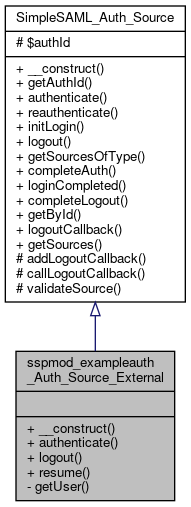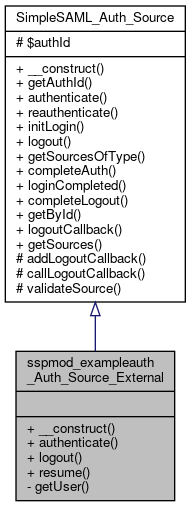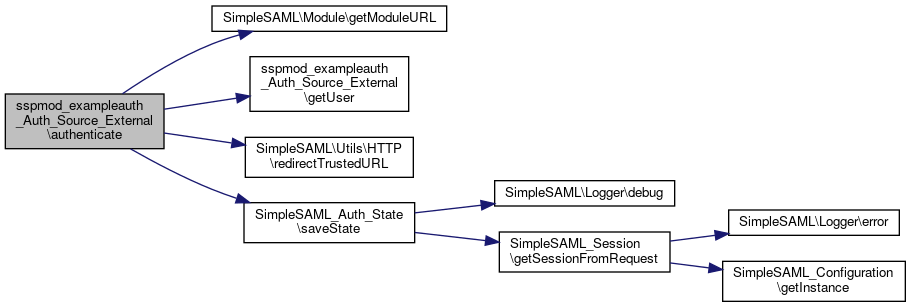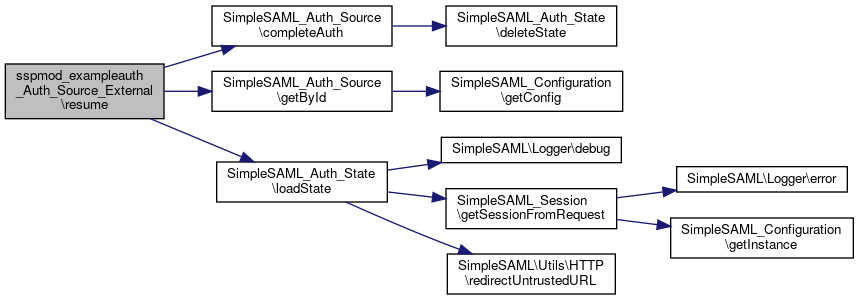 Inheritance diagram for sspmod_exampleauth_Auth_Source_External:
Inheritance diagram for sspmod_exampleauth_Auth_Source_External: Collaboration diagram for sspmod_exampleauth_Auth_Source_External:
Collaboration diagram for sspmod_exampleauth_Auth_Source_External:Public Member Functions | |
| __construct ($info, $config) | |
| Constructor for this authentication source. More... | |
| authenticate (&$state) | |
| Log in using an external authentication helper. More... | |
| logout (&$state) | |
| This function is called when the user start a logout operation, for example by logging out of a SP that supports single logout. More... | |
 Public Member Functions inherited from SimpleSAML_Auth_Source Public Member Functions inherited from SimpleSAML_Auth_Source | |
| __construct ($info, &$config) | |
| Constructor for an authentication source. More... | |
| getAuthId () | |
| Retrieve the ID of this authentication source. More... | |
| authenticate (&$state) | |
| Process a request. More... | |
| reauthenticate (array &$state) | |
| Reauthenticate an user. More... | |
| initLogin ($return, $errorURL=null, array $params=array()) | |
| Start authentication. More... | |
| logout (&$state) | |
| Log out from this authentication source. More... | |
Static Public Member Functions | |
| static | resume () |
| Resume authentication process. More... | |
 Static Public Member Functions inherited from SimpleSAML_Auth_Source Static Public Member Functions inherited from SimpleSAML_Auth_Source | |
| static | getSourcesOfType ($type) |
| Get sources of a specific type. More... | |
| static | completeAuth (&$state) |
| Complete authentication. More... | |
| static | loginCompleted ($state) |
| Called when a login operation has finished. More... | |
| static | completeLogout (&$state) |
| Complete logout. More... | |
| static | getById ($authId, $type=null) |
| Retrieve authentication source. More... | |
| static | logoutCallback ($state) |
| Called when the authentication source receives an external logout request. More... | |
| static | getSources () |
| Retrieve list of authentication sources. More... | |
Private Member Functions | |
| getUser () | |
| Retrieve attributes for the user. More... | |
Additional Inherited Members | |
 Protected Member Functions inherited from SimpleSAML_Auth_Source Protected Member Functions inherited from SimpleSAML_Auth_Source | |
| addLogoutCallback ($assoc, $state) | |
| Add a logout callback association. More... | |
| callLogoutCallback ($assoc) | |
| Call a logout callback based on association. More... | |
 Static Protected Member Functions inherited from SimpleSAML_Auth_Source Static Protected Member Functions inherited from SimpleSAML_Auth_Source | |
| static | validateSource ($source, $id) |
| Make sure that the first element of an auth source is its identifier. More... | |
 Protected Attributes inherited from SimpleSAML_Auth_Source Protected Attributes inherited from SimpleSAML_Auth_Source | |
| $authId | |
Detailed Description
Definition at line 23 of file External.php.
Constructor & Destructor Documentation
◆ __construct()
| sspmod_exampleauth_Auth_Source_External::__construct | ( | $info, | |
| $config | |||
| ) |
Constructor for this authentication source.
- Parameters
-
array $info Information about this authentication source. array $config Configuration.
Definition at line 31 of file External.php.
Member Function Documentation
◆ authenticate()
| sspmod_exampleauth_Auth_Source_External::authenticate | ( | & | $state | ) |
Log in using an external authentication helper.
- Parameters
-
array &$state Information about the current authentication.
Reimplemented from SimpleSAML_Auth_Source.
Definition at line 92 of file External.php.
References $attributes, SimpleSAML_Auth_Source\$authId, $returnTo, $state, $stateId, SimpleSAML\Module\getModuleURL(), getUser(), SimpleSAML\Utils\HTTP\redirectTrustedURL(), and SimpleSAML_Auth_State\saveState().
 Here is the call graph for this function:
Here is the call graph for this function:◆ getUser()
|
private |
Retrieve attributes for the user.
- Returns
- array|NULL The user's attributes, or NULL if the user isn't authenticated.
Definition at line 47 of file External.php.
References $_SESSION, and $attributes.
Referenced by authenticate().
 Here is the caller graph for this function:
Here is the caller graph for this function:◆ logout()
| sspmod_exampleauth_Auth_Source_External::logout | ( | & | $state | ) |
This function is called when the user start a logout operation, for example by logging out of a SP that supports single logout.
- Parameters
-
array &$state The logout state array.
Reimplemented from SimpleSAML_Auth_Source.
Definition at line 253 of file External.php.
◆ resume()
|
static |
Resume authentication process.
This function resumes the authentication process after the user has entered his or her credentials.
- Parameters
-
array &$state The authentication state.
Definition at line 177 of file External.php.
References $attributes, $source, $state, SimpleSAML_Auth_Source\completeAuth(), SimpleSAML_Auth_Source\getById(), and SimpleSAML_Auth_State\loadState().
 Here is the call graph for this function:
Here is the call graph for this function:The documentation for this class was generated from the following file:
- libs/composer/vendor/simplesamlphp/simplesamlphp/modules/exampleauth/lib/Auth/Source/External.php





